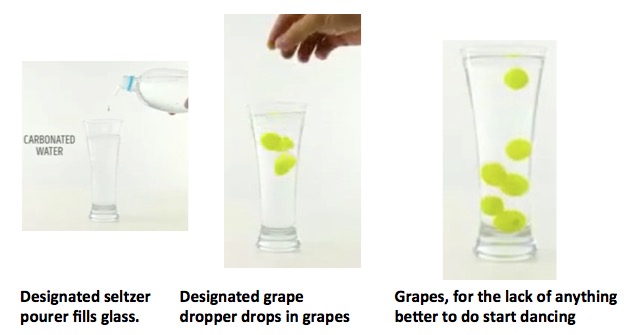
It's a Friday before a three-day weekend. Brain is fried. Concentration, which isn't all that hot on a good day, is... what's that word?
Which means that it's a good time to do something fun. So here is a "5-minute crafts" video clip (https://youtu.be/mdMAYqQPLqs) of yellow and blue water which seems to show that if you put one color on top, you get three layers of colors, while the other results in just one.
For extra fun, I've written an explanation for why all this stuff is happening.
Experiment # 1: Yellow and blue make green. More or less. 
Explanation: Warm water is less dense than cold. So the warm layer floats on top. (This same effect is responsible for how warm the ocean is on a given day. (See: 3 Things You Probably Don't Know About The Ocean.). Once the warm water cools, the two will mix completely. You can see this beginning at the green interface.
Experiment # 2: Yellow and blue make green. More, not less.

Explanation: Experiment #2 is the opposite of #1. This time the cold (blue) water is denser so it sinks immediately when added to the yellow solution. The two colors to mix immediately.
Experiment # 3: A sucking candle.
Explanation: Just like with water, hot air is less dense than cold. But this experiment is a little different. Unlike liquids which expand imperceptibly, gases expand like crazy when heated. Once the glass is placed over the candle the air is heated and it expands. The resulting pressure forces some air out of the glass (the bubbles). When the oxygen is consumed the flame goes out. Then the air cools and contracts. This results in a vacuum which draws the blue solution into the glass.
Experiment #4: Dancing Grapes.

Grapes are denser than water (and also carbonated water) so when they are dropped into the glass they sink to the bottom. Carbon dioxide bubbles adhere to the surface of the grapes. When enough of the bubbles have latched onto the grape it becomes buoyant and floats to the top. The CO2 bubbles burst and the grape sinks again where it picks up some more CO2 (sung to the tune of The Itsy Bitsy Spider).
Experiment #5: A five-layer cake without the cake.

Explanation: Figure it out for yourself. This should be good. Feel free to leave answers in the comments section.
Have a happy (and colorful) Columbus Day.



